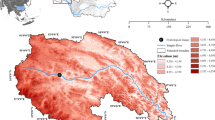Abstract
In order to study the function, hydrodynamic behavior, and hydraulic properties of the karst aquifers in Izeh, southwest Iran, time series analysis was applied to the precipitation, spring discharge, and piezometric head data of two representative karst systems of Zagros (Ilam-Sarvak and Asmari Formations). Time series analysis was applied to two karst aquifers, those of Asmari and Ilam-Sarvak Formations. The daily precipitations of anticlines were estimated based on the precipitation–elevation function which was applied on digital elevation model (DEM) of the area. The mean estimated daily precipitations were considered in bivariate time series analysis as input data of each karst system. The total length of time series was about 2.7 years, extending from May 2007 to December 2009. During the research, several one-parameter probe data loggers were installed, which daily measure the water surfaces in karst aquifers. Time series analysis was applied for describing Izeh karst aquifers with a focus on both univariate (autocorrelation and spectral analysis) and bivariate (cross-correlation, gain function, and coherency function) methods. The results show that Asmari karst aquifer in Kamarderaz Anticline has a large storage capacity. Because of lacking a well-organized karst network, in the Asmari karst aquifer, baseflow dominates with low contribution of quick-flow. In the Ilam-Sarvak karst aquifer (Shavish and Tanush Anticlines), the karstification occurred in fractures and small diameter conduits, which caused to quick-flow between dense limestone. The Ilam-Sarvak karst aquifer could be regarded as a transition between two extreme types of karst, e.g., highly karstified system and in the opposite, extremely diffused one. The analysis of well hydrograph in Ilam-Sarvak karst aquifer shows that the karst aquifer has a low storage capacity. Unlike Asmari karst aquifer, the fractures and small diameter conduits in Ilam-Sarvak karst aquifer are more enhanced, producing a better developed karst network. Contrary to the typical karst systems, however, diffuse flow and conduit flow coexist in the Asmari Formation.










Similar content being viewed by others
References
Abusaada M, Sauter M (2012) Studying the flow dynamics of a karst aquifer system with an equivalent porous medium model. Groundwater. doi:10.1111/j.1745-6584.2012.01003.x
Bonacci O (1993) Karst springs hydrographs as indicators of karst aquifers. Hydrol Sci J 38:51–62
Bouchaou L, Mangin A, Chauve P (2002) Turbidity mechanism of water from a karstic spring: example of the Ain Asserdoune spring (Beni Mellal Atlas, Morocco). J Hydrol 265:34–42
Box GEP, Jenkins GM, Reinsel GC (1994) Time series analysis: forecasting and control, 3rd edn. Prentice Hall Inc., Englewood Cliffs, NJ, USA
Eisenlohr L, Bouzelboudjen M, Kira´ly L, Rossier Y (1997) Numerical versus statistical modeling of natural response of a karst hydrogeological system. J Hydrol 202:244–262
Ford DC, Williams PW (2007) Karst geomorphology and hydrology, 2nd edn. John Wiley & Sons, Chichester, U.K., 576 pp
Jenkins GM, Watts DG (1968) Spectral analysis and its applications. Holden Day, San Francisco, CA, 525pp
Khuzestan Water and Power Authority (KWPA) (2009) Monitoring of groundwater levels. In Persian.
Kovács A (2003) Geometry and hydraulic parameters of karst aquifers: A hydrodynamic modeling approach. PhD. Thesis, University Neuchâtel, Suisse, 131pp.
Lambrakis N, Andreou AS, Polydoropoulos P, Georgopoulos E, Bountis T (2000) Nonlinear analysis and forecasting of a brackish karstic spring. Water Resour Res 36(4):875–884
Larocque M, Mangin A, Razack M, Banton O (1998) Contribution of correlation and spectral analyses to the regional study of a large karst aquifer (Charente, France). J Hydrol 205:217–231
Lee JY, Lee KK (2000) Use of hydrologic time series data for identification of recharge mechanism in a fractured bedrock aquifer system. J Hydrol 229:190–201
Maillet E (1905) Essais d’Hydraulique Souterraine et Fluviale. Herman, Paris, France
Mangin A (1984) Pour une meilleure connaissance des systèmes hydrologiques à partir des analyses corrélatoire et spectrale. J Hydrol 67:25–43
Milanovic´ P (1981) Karst hydrogeology. W.R.P, Colorado, 434pp
Padilla A, Pulido-Bosch A (1995) Study of hydrographs of karstic aquifers by means of correlation and cross-spectral analysis. J Hydrol 168:73–89
Padilla A, Pulido A, Mangin A (1994) Relative importance of baseflow and quickflow from hydrographs of karst spring. Ground Water. 32(2):267–277
Panagopoulos G, Lambrakis N (2005) Groundwater responses to recharge and human-induced stresses in the Trifilia karst aquifer, Greece. In: Krasny J, Hrkal Z, Bruthans J (eds) Proceedings of International Conference on Groundwater in Fractured Rocks, IHP-VI, Series on Groundwater, 7:167–168
Panagopoulos G, Lambrakis N (2006) The contribution of time series analysis to the study of the hydrodynamic characteristics of the karst systems: application on two typical karst aquifers of Greece (Trifilia, Almyros Crete). J Hydrol 329:368–376
Rahnemaei M, Zare M, Nematollahi AR, Sedghi H (2005) Application of spectral analysis of daily water level and spring discharge hydrographs data for comparing physical characteristics of karstic aquifers. J Hydrol 311:106–116
Samani N (2001) Response of karst aquifers to rainfall and evaporation, Maharlu Basin, Iran. J Cave Karst Stud 63(1):33–40
Water and Soil Consulting Engineers (2009) Sub-detail study of water resources of Izeh. Khuzestan Water and Power Authority (KWPA), In Persian.
Author information
Authors and Affiliations
Corresponding author
Rights and permissions
About this article
Cite this article
Nassery, H.R., Alijani, F. & Nakhaei, M. The comparison of hydrodynamic characteristics of karst aquifers: application on two karst formations in Zagros (Asmari and Ilam-Sarvak), southwest Iran. Arab J Geosci 7, 4809–4818 (2014). https://doi.org/10.1007/s12517-013-1017-z
Received:
Accepted:
Published:
Issue Date:
DOI: https://doi.org/10.1007/s12517-013-1017-z




